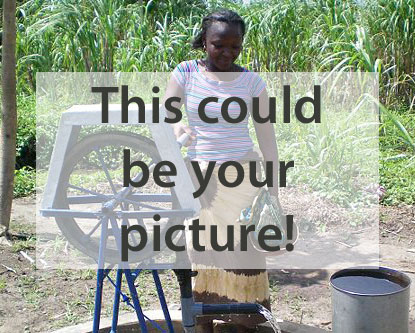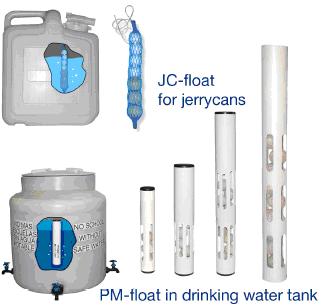Plation float
All Plation® products are based on inactivation of (pathogenic) bacteria by silver ions. The use of silver as a water purification technique goes back millennia and is a proven method. The silver ions are released by a natural ionization process by using special ceramic balls with a coating of pure, high quality colloidal silver (microscopic small silver particles). For heavily contaminated drinking water as well as rooftop harvested rainwater, silver-ceramic balls are combined with metallic copper, as copper and silver ions together are even more effective against bacteria, algae and other microbiological contaminations.
AquaEst offers a wide range of products. Plation floats are primarily designed for preservation of drinking water in tanks and cisterns. Product range for tank sizes of 50 up to 6.000 litres. Plation PM is encased in rigid plastic tube. Plation PNS, PNK and JC are kept secured with open mesh food plastic. Plation floats are the only known non chemical, non toxic technique to preserve (drinking) water during storage to ensure fresh and safe drinking water quality. The Floats can also be used for purfication/disinfection, either alone (with a proper exposure time) or complementary to other technologies such as activated carbon, UV and RO.
There are examples of hybrid use with WaterPyramid projects and rainwater harvesting systems. For application in third world countries, support from local government or NGO is required
| Advantages | Disadvantages/limitations |
|---|---|
| - No electricity needed - Low maintenance - Leaves no taste, smell or colour in the water - Extremely simple operation: Plation floats in the water - Relatively long lifetime (1-2 years) - Robust product, not breakable (transport) |
- Not 100% effective against viruses Preliminary disinfection using chlorine or other disinfectant might be needed when dealing with heavy microbially contaminated water and less storage/contact time - Not easy to notice when product is no longer effective Relatively high product costs Release of small amounts of copper and silver |
History and social context
Suitable conditions
The plation float is most appropriate application as a water quality preservation step during storage period. It can be used in combination with other treatment methods, such as a Rain Water Harvesting (RWH) system* or WaterPyramid. Further it is applicable in water trucks, storage tanks for purified water produced by UV, RO, etc. as quite often water quality gets contaminated during transport and storage.
|
|
Technical specification
Operation
Operation is very simple. Simply clean container before using it as a storage vessel. Immerse the plation floats in the water container, and leave them to act.
Maintenance
Practically no maintenance required.
Manufacturing
Estimated Lifespan
Public water: 2 years Chlorinated public water: 1 to 1,5 years (depending on chlorine concentration) Rainwater: 1 year, when rainwater is treated with Plation filters/RainPC, 2 years
Suppliers
AquaEst
robustness
No moving parts
Cost
It is assumed that the silver will last for maximum 2 years. Presented in ranges that represent different capacity ranging from 50-6000 litres the costs are:
| Capital cost | Operating cost | Replacement cost | Estimated 5 year cost | Cost / metre cubed treated |
|---|---|---|---|---|
| €27,40-337,80 | After 2 years maximum | €0,75 (based on 50 litres per day for JC50) |
Country experiences
Manuals
Movies
Footnotes
Acknowledgements
This article is based on a factsheet from Centre for Affordable Water and Sanitation Technology (CAWST), which is gratefully acknowledged.
External Links
References

|

